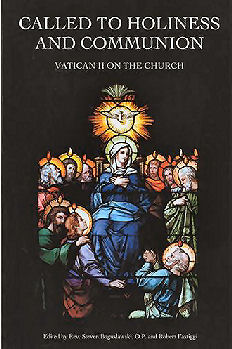
|
Posted November 7, 2010
Book: Called to Holiness and Communion: Vatican II on the Church Edited by Rev. Steven Bogulawski, OP, and Robert Fastiggi University of Scranton Press. Scranton, PA. 2009. Pp.400 An Excerpt from the Foreword:
Again, because of a confluence of various factors and the mysterious hand of the Holy Spirit, over the past decade, Sacred Heart Major Seminary in Detroit and the Pope John Paul II Cultural Center in Washington, D.C., have shared many resources and common experiences. Both of these institutions have a deep abiding commitment to the message and witness of the late Pope John Paul II, especially his understanding of the necessary connection of faith and culture in the work of the New Evangelization. November 12-15, 2003, Sacred Heart Major Seminary, in conjunction with the Pope John Paul II Cultural Center sponsored a special conference, “Called to Holiness and Communion” which included a number of cardinals, theologians, and philosophers of international reputation. I am pleased to share with you the work of this conference, now available as “Called to Holiness and Communion: Vatican II on the Church” published by University of Scranton Press. An Excerpt from the Book: The Family: Sign of Communion in the New Evangelization Carl A. Anderson The topic of this essay, “The Family: Sign of Communion in the New Evangelization” is precisely right for a volume dealing with “The Call to Holiness and Communion: Vatican II on the Church.” In promulgating the Catechism of the Catholic Church in 1992, Pope John Paul II stated, “For me. . .Vatican II has always been, and especially during these years of my Pontificate, the constant point of my every pastoral action, in the conscious commitment to implement its directives concretely and faithfully.” It is not surprising then, that Pope John Paul II would begin his Letter to Families [1994] with a meditation on Gaudium et spes. He writes, if “man is the way of the Church,” then the family is the first and the most important way of the Church. The pope is clear about this fundamental insight of the Council itself, that unlike the various ideologies of the modern age, the human person cannot be successfully understood as an abstraction — that is, isolated from the context of family life. Instead, each person must be seen in the concreate reality of his daily life. As the Counsel itself says in the opening paragraphs of Gaudium et Spes: “It is man. . . who is key . . .man considered whole and entire, with body and soul, heart and conscience, mind and will.” And for John Paul II, this must include consideration of man as he lives in the family. At the conclusion of the Letter to Families, the pope emphasizes, “the family is placed at the center of the great struggle between good and evil, between life and death, between love and all that is opposed to love.” In Evangelium vitae he wrote, “The role of the family in building a culture of life is decisive and irreplaceable.” Less publicly, he has observed that the family is the fundamental point of encounter between the Church and contemporary culture. With these points in mind, it is clear that the family must be seen as both subject and object of the “new evangelization.” Indeed, the evangelization of the family is a hallmark of the new evangelization and is at its center. It is hardly possible to conceptualize a “new evangelization” faithful to the thought of John Paul II that is not centered upon the Church’s mission to marriage and family. Table of Contents: 1. Trends in ecclesiology 2. Christ, the light of nations. The church, his spouse and helpmate 3. Christ, the measure for the inculturation of the Gospel. His church, the universal sacrament of salvation. 4. “Officium signa temporum perscrutandi: new encounters of Gospel and culture in the context of the new evangelization 5. The Eucharistic liturgy as the source and summit of the church’s communion 6. Exploring the identity of the bishop through the theology of disclosure 7. The Petrine mystery and the indefectibility of the church 8. “Pastores dabo vobis: establishing an ecclesial culture for the clergy 9. The renewal of religious life: strengthening the Trinitarian communio of the church 10. Disciples in the midst of the world: collaboration of the lay faithful in the sacred ministry of priests 11. The family: sign of communion in the new evangelization 12. The authority of women in the Catholic church 13. “Humanae vitae: and the “Sensus fidelium” of a contraceptive culture 14. The ecclesial vocation of the theologian in the setting of Catholic higher education 15. The influence of biblical studies on ecclesial self-understanding since Vatican II 16. Living communion within American polity |
|
